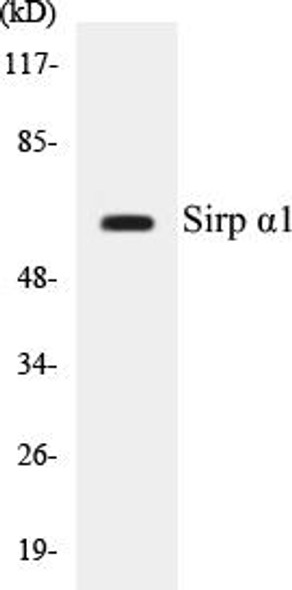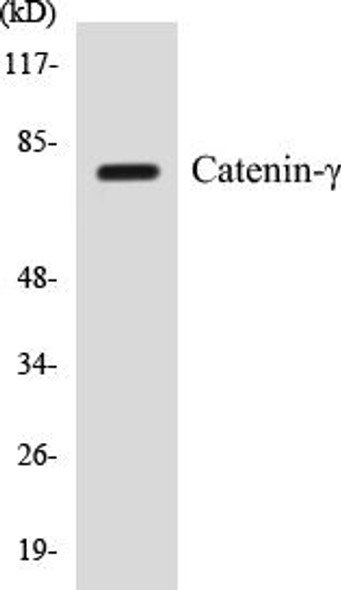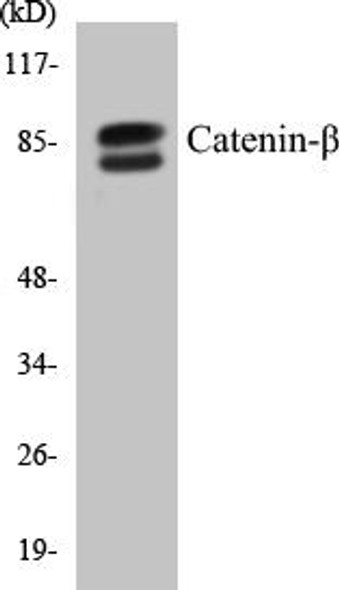Cell Biology
Catenin-alpha1 Colorimetric Cell-Based ELISA Kit
- SKU:
- CBCAB00565
- Product Type:
- ELISA Kit
- ELISA Type:
- Cell Based
- Research Area:
- Cell Biology
- Reactivity:
- Human
- Reactivity:
- Mouse
- Reactivity:
- Rat
- Detection Method:
- Colorimetric
Description
| Product Name: | Catenin-alpha1 Colorimetric Cell-Based ELISA |
| Product Code: | CBCAB00565 |
| ELISA Type: | Cell-Based |
| Target: | Catenin-alpha1 |
| Reactivity: | Human, Mouse, Rat |
| Dynamic Range: | > 5000 Cells |
| Detection Method: | Colorimetric 450 nmStorage/Stability:4°C/6 Months |
| Format: | 96-Well Microplate |
The Catenin-alpha1 Colorimetric Cell-Based ELISA Kit is a convenient, lysate-free, high throughput and sensitive assay kit that can detect Catenin-alpha1 protein expression profile in cells. The kit can be used for measuring the relative amounts of Catenin-alpha1 in cultured cells as well as screening for the effects that various treatments, inhibitors (ie siRNA or chemicals), or activators have on Catenin-alpha1.
Qualitative determination of Catenin-alpha1 concentration is achieved by an indirect ELISA format. In essence, Catenin-alpha1 is captured by Catenin-alpha1-specific primary antibodies while the HRP-conjugated secondary antibodies bind the Fc region of the primary antibody. Through this binding, the HRP enzyme conjugated to the secondary antibody can catalyze a colorimetric reaction upon substrate addition. Due to the qualitative nature of the Cell-Based ELISA, multiple normalization methods are needed:
| 1. | A monoclonal antibody specific for human GAPDH is included to serve as an internal positive control in normalizing the target absorbance values. |
| 2. | Following the colorimetric measurement of HRP activity via substrate addition, the Crystal Violet whole-cell staining method may be used to determine cell density. After staining, the results can be analysed by normalizing the absorbance values to cell amounts, by which the plating difference can be adjusted. |
| Database Information: | Gene ID: 1495/1496, UniProt ID: P35221, OMIM: 116805/114025, Unigene: Hs.445981/Hs.656653/Hs.167368/Hs.476018 |
| Gene Symbol: | CTNNA1/CTNNA2 |
| Sub Type: | None |
| UniProt Protein Function: | CTNNA1: Associates with the cytoplasmic domain of a variety of cadherins. The association of catenins to cadherins produces a complex which is linked to the actin filament network, and which seems to be of primary importance for cadherins cell-adhesion properties. Can associate with both E- and N-cadherins. Originally believed to be a stable component of E-cadherin/catenin adhesion complexes and to mediate the linkage of cadherins to the actin cytoskeleton at adherens junctions. In contrast, cortical actin was found to be much more dynamic than E-cadherin/catenin complexes and CTNNA1 was shown not to bind to F-actin when assembled in the complex suggesting a different linkage between actin and adherens junctions components. The homodimeric form may regulate actin filament assembly and inhibit actin branching by competing with the Arp2/3 complex for binding to actin filaments. May play a crucial role in cell differentiation. Monomer and homodimer; the monomer preferentially binds to CTNNB1 and the homodimer to actin. Binds MLLT4 and F-actin. Possible component of an E-cadherin/ catenin adhesion complex together with E-cadherin/CDH1 and beta-catenin/CTNNB1 or gamma- catenin/JUP; the complex is located to adherens junctions. The stable association of CTNNA1 is controversial as CTNNA1 was shown not to bind to F-actin when assembled in the complex. Alternatively, the CTNNA1-containing complex may be linked to F- actin by other proteins such as LIMA1. Interacts with ARHGAP21 and with AJUBA. Interacts with LIMA1. Expressed ubiquitously in normal tissues. Belongs to the vinculin/alpha-catenin family. 2 isoforms of the human protein are produced by alternative splicing. |
| UniProt Protein Details: | Protein type:Motility/polarity/chemotaxis; Actin-binding Chromosomal Location of Human Ortholog: 5q31.2 Cellular Component: focal adhesion; lamellipodium; acrosome; plasma membrane; catenin complex; zonula adherens; intercellular junction; cytosol; actin cytoskeleton Molecular Function:actin filament binding; protein binding; cadherin binding; gamma-catenin binding; beta-catenin binding; structural molecule activity; vinculin binding Biological Process: intercellular junction assembly and maintenance; apical junction assembly; gap junction assembly; protein heterooligomerization; axon regeneration; male gonad development; establishment and/or maintenance of cell polarity; actin filament organization; odontogenesis of dentine-containing teeth; muscle cell differentiation; negative regulation of neuroblast proliferation; ovarian follicle development; response to estrogen stimulus; positive regulation of smoothened signaling pathway; positive regulation of muscle cell differentiation; cell adhesion; vascular endothelial growth factor receptor signaling pathway; aging |
| UniProt Code: | P35221 |
| NCBI GenInfo Identifier: | 461853 |
| NCBI Gene ID: | 1495 |
| NCBI Accession: | P35221.1 |
| UniProt Secondary Accession: | P35221,Q12795, Q8N1C0, |
| UniProt Related Accession: | P35221 |
| Molecular Weight: | 59,550 Da |
| NCBI Full Name: | Catenin alpha-1 |
| NCBI Synonym Full Names: | catenin (cadherin-associated protein), alpha 1, 102kDa |
| NCBI Official Symbol: | CTNNA1 |
| NCBI Official Synonym Symbols: | CAP102 |
| NCBI Protein Information: | catenin alpha-1; alpha-catenin; alphaE-catenin; alpha E-catenin; alpha-E-catenin; renal carcinoma antigen NY-REN-13; cadherin-associated protein,102kDa |
| UniProt Protein Name: | Catenin alpha-1 |
| UniProt Synonym Protein Names: | Alpha E-catenin; Cadherin-associated protein; Renal carcinoma antigen NY-REN-13 |
| Protein Family: | Catenin |
| UniProt Gene Name: | CTNNA1 |
| UniProt Entry Name: | CTNA1_HUMAN |
| Component | Quantity |
| 96-Well Cell Culture Clear-Bottom Microplate | 2 plates |
| 10X TBS | 24 mL |
| Quenching Buffer | 24 mL |
| Blocking Buffer | 50 mL |
| 15X Wash Buffer | 50 mL |
| Primary Antibody Diluent | 12 mL |
| 100x Anti-Phospho Target Antibody | 60 µL |
| 100x Anti-Target Antibody | 60 µL |
| Anti-GAPDH Antibody | 60 µL |
| HRP-Conjugated Anti-Rabbit IgG Antibody | 12 mL |
| HRP-Conjugated Anti-Mouse IgG Antibody | 12 mL |
| SDS Solution | 12 mL |
| Stop Solution | 24 mL |
| Ready-to-Use Substrate | 12 mL |
| Crystal Violet Solution | 12 mL |
| Adhesive Plate Seals | 2 seals |
The following materials and/or equipment are NOT provided in this kit but are necessary to successfully conduct the experiment:
- Microplate reader able to measure absorbance at 450 nm and/or 595 nm for Crystal Violet Cell Staining (Optional)
- Micropipettes with capability of measuring volumes ranging from 1 µL to 1 ml
- 37% formaldehyde (Sigma Cat# F-8775) or formaldehyde from other sources
- Squirt bottle, manifold dispenser, multichannel pipette reservoir or automated microplate washer
- Graph paper or computer software capable of generating or displaying logarithmic functions
- Absorbent papers or vacuum aspirator
- Test tubes or microfuge tubes capable of storing ≥1 ml
- Poly-L-Lysine (Sigma Cat# P4832 for suspension cells)
- Orbital shaker (optional)
- Deionized or sterile water
*Note: Protocols are specific to each batch/lot. For the correct instructions please follow the protocol included in your kit.
| Step | Procedure |
| 1. | Seed 200 µL of 20,000 adherent cells in culture medium in each well of a 96-well plate. The plates included in the kit are sterile and treated for cell culture. For suspension cells and loosely attached cells, coat the plates with 100 µL of 10 µg/ml Poly-L-Lysine (not included) to each well of a 96-well plate for 30 minutes at 37°C prior to adding cells. |
| 2. | Incubate the cells for overnight at 37°C, 5% CO2. |
| 3. | Treat the cells as desired. |
| 4. | Remove the cell culture medium and rinse with 200 µL of 1x TBS, twice. |
| 5. | Fix the cells by incubating with 100 µL of Fixing Solution for 20 minutes at room temperature. The 4% formaldehyde is used for adherent cells and 8% formaldehyde is used for suspension cells and loosely attached cells. |
| 6. | Remove the Fixing Solution and wash the plate 3 times with 200 µL 1x Wash Buffer for five minutes each time with gentle shaking on the orbital shaker. The plate can be stored at 4°C for a week. |
| 7. | Add 100 µL of Quenching Buffer and incubate for 20 minutes at room temperature. |
| 8. | Wash the plate 3 times with 1x Wash Buffer for 5 minutes each time. |
| 9. | Add 200 µL of Blocking Buffer and incubate for 1 hour at room temperature. |
| 10. | Wash 3 times with 200 µL of 1x Wash Buffer for 5 minutes each time. |
| 11. | Add 50 µL of 1x primary antibodies (Anti-Catenin-alpha1 Antibody and/or Anti-GAPDH Antibody) to the corresponding wells, cover with Parafilm and incubate for 16 hours (overnight) at 4°C. If the target expression is known to be high, incubate for 2 hours at room temperature. |
| 12. | Wash 3 times with 200 µL of 1x Wash Buffer for 5 minutes each time. |
| 13. | Add 50 µL of 1x secondary antibodies (HRP-Conjugated AntiRabbit IgG Antibody or HRP-Conjugated Anti-Mouse IgG Antibody) to corresponding wells and incubate for 1.5 hours at room temperature. |
| 14. | Wash 3 times with 200 µL of 1x Wash Buffer for 5 minutes each time. |
| 15. | Add 50 µL of Ready-to-Use Substrate to each well and incubate for 30 minutes at room temperature in the dark. |
| 16. | Add 50 µL of Stop Solution to each well and read OD at 450 nm immediately using the microplate reader. |
(Additional Crystal Violet staining may be performed if desired – details of this may be found in the kit technical manual.)






